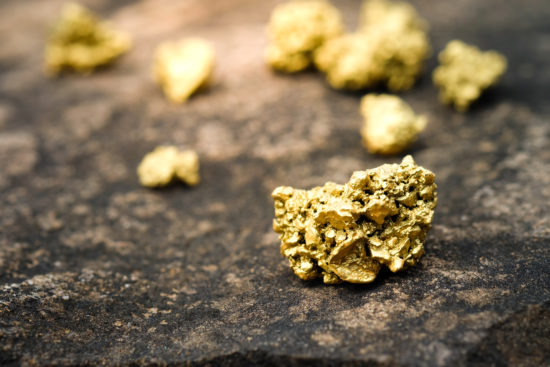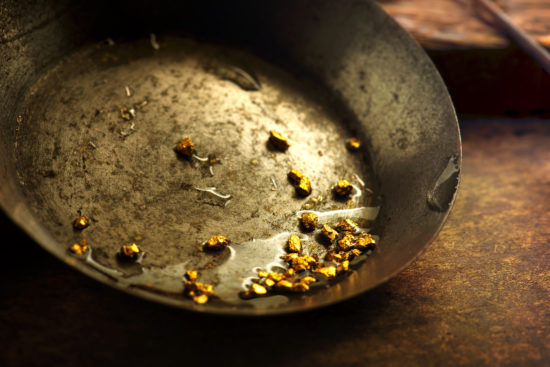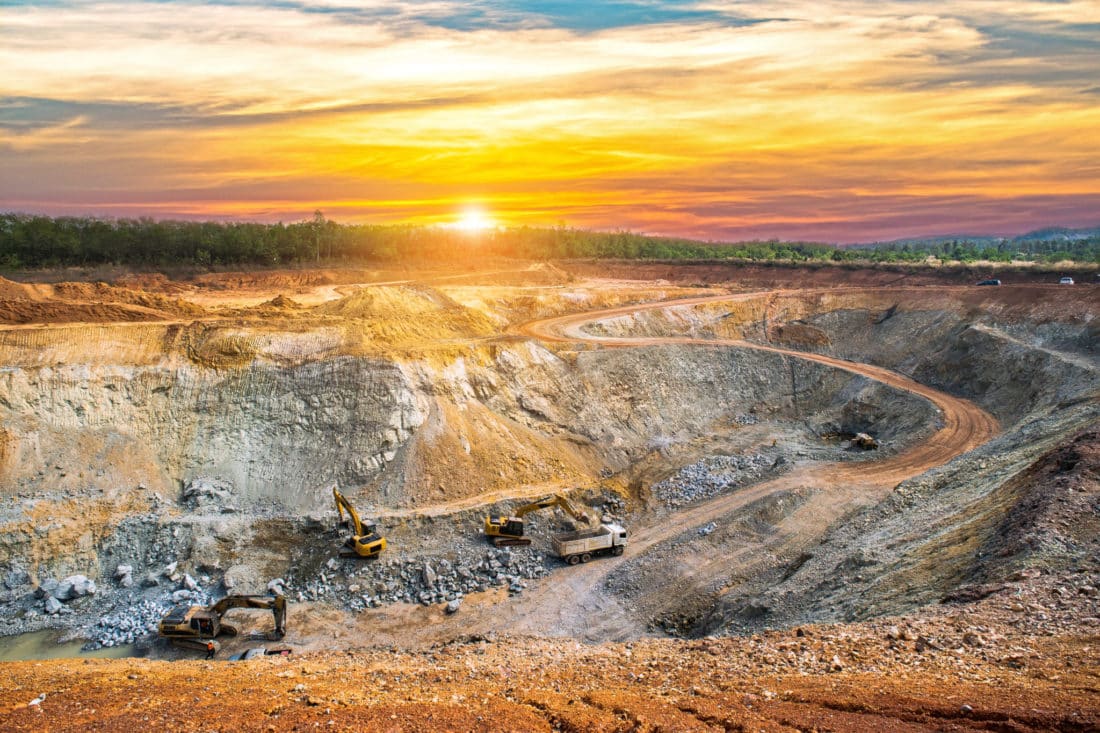Gold has long been treasured all over the world, given equal value by ancient civilizations on opposite sides of the planet. Despite the metal being ingrained in our culture, particularly our view of wealth, most people have no idea where it comes from. Approximately 2500 tons of gold is mined globally every year, some of which from gold mines large enough to be seen from space. However, we know our supply is steadily running out, leading some to ask; is there a lack of physical gold? To understand the answer to this question, you need to understand how the gold supply chain works, and how much is still left underground.
In this article, we’ll examine exactly how gold came to be on our planet, and where you can find naturally occurring precious metals. Next, you’ll learn about the countries and locations which produce the most gold each year, and where the largest goldfields ever discovered are found. From remote volcanic islands to locations high in the mountains, this precious metal has been prospected in almost every corner of the world. Read on to discover all you need to know about where gold has historically come from, and where we might mine it from in the future.
Where Is Gold Found?
Gold can be found naturally in a number of locations, which are split into two categories. All the gold found and mined throughout the world comes under one of these classifications. Mining companies most commonly seek primary gold, which is found in rock formations. If the amount of gold is large enough, mining operations could commence removing the precious metal from the earth. Secondary gold can also be lucrative when found but is more interesting to individual gold prospectors than huge mining corporations.
Primary gold is often found in rock formations alongside many other valuable precious metals and minerals, such as silver and quartz. Gold deposits like these are highly valuable to mining companies, as they can sell not only the gold ore but the other rare minerals as well. This is called lode mining when gold and other elements are extracted as hard rock.
Secondary gold actually comes from primary gold and is often found in streams, rivers, waterways, and creek beds. This secondary gold, called placer gold, is a result of millions of years of erosion of primary gold. Wind, water, and temperature changes can flush minerals from rock formations, in the form of gold dust, fine grains, and even nuggets. These find their way into various waterways and can travel extreme distances. When found, they can be mined through a process called panning and collected as solid gold.

Gold can be found beneath the earth on all seven continents.
Where Did Gold Come From?
So you know the different places where gold can be found, but how did this precious metal end up beneath our earth’s crust? This element arrived on our planet around 200 million years after its creation, when meteorites full of gold and other metals hurtled into the surface from space. Later, as the planet’s formation shifted, a vast quantity of molten iron sank to the earth’s core, and with it took almost all the precious metals on earth. The amount is estimated to include enough gold, platinum, and other precious metals in a 4-meter thick layer.
In the many millennia, since this occurred, varying amounts of gold and other minerals have been transported up to the earth’s crust, where it is accessible to our mining operations. Superheated fluid from the core of the earth flows upwards towards the crust, depositing gold in rock crevices. This process forms primary gold, and in turn creates secondary gold, providing this incredibly useful precious metal to us.
Where is Gold Found on Earth?
An estimated 244,000 metric tons of gold have been discovered in total throughout the world. Of that, 187,000 was mined historically while an estimated 57,000 remains in underground gold veins yet to be dug up. While gold has been found on almost every continent, most of this gold was found in one of three countries; China, Australia, and South Africa. However, you can find trace amounts of gold almost anywhere you look, even in seawater and within the human body.
Other than the countries we previously mentioned, huge deposits of gold have been found in:
- The United States
- Canada
- Indonesia
- Peru
- Japan
- India
- Mexico
Even combined together, all the gold discovered in the world would only amount to a 28-meter cube. This rarity is one of the aspects which drives gold to be so valuable, and one element humans still desperately seek to discover today. Now, let’s dive a bit deeper into all the locations, current and historical, which have been abundant sources of this shiny yellow metal.
The United States
Gold was first discovered in the USA in North Carolina, 1799. However, it wasn’t until the California Gold Rush in 1848 that truly huge changes were made to the US economy because of gold. This country’s gold production peaked in the 1980s when discoveries like the 2nd largest-ever goldfield in Nevada revealed vast amounts of fresh wealth. In 2016, the USA ranked 4th in gold production, as gold has been discovered in major amounts across 18 different states. We’ll now go into more detail about a few of the most important places where gold is found in the United States.
Carlin Trend, Nevada
The Carlin Gold Trend is one of the world’s most bountiful mining districts. It’s second only to the Witwatersrand Basin in South Africa. This belt of gold deposits in Nevada is about 5 miles wide and stretches a huge 40 miles through the town of Carlin. American prospectors failed to notice the huge goldfield for decades, as there were no gold veins visible to the naked eye. That’s because the majority of Carlin Trend’s precious metal deposits were secondary gold. Hot springs had broken down the element into fine particles and distributed it in sandy sediment.
Gold was first found in Nevada in the 1870s, but production was slow and the mine produced only 22,000 ounces of gold by 1964. However, the Newmont Mining Company started mining from the Carlin Gold trend in 1965 and found much more success. By 2008, the Carlin Trend gold deposit had produced more than 70 million ounces of gold, worth back then around $80 billion USD.
Gold Country, California
Located on the western slope of the Sierra Nevada in northern California, the region of Gold Country has huge historical significance. Gold was discovered here in 1949, triggering the famous California Gold Rush. In the next few years, waves of immigrants amounting to hundreds of thousands of “49ers” traveled to the State of California to seek better fortunes in the gold industry. This influx of hopeful prospectors from around the world grew cities and led to the construction of the first railroad in California, straight through Gold Country.
At first, gold was mostly mined by panning, a process of sifting through the sediment from places such as river beds, hoping to discover a few tiny nuggets of shiny yellow gold. As technology improved, hydraulic mining was used to send pressurized water to loosen sediment from rock formations and carry it for processing. An estimated 20 million ounces of gold were mined from the California Gold Country using various methods.
Alaska
Russian explorers discovered placer gold in Alaska in 1848, but it wasn’t until after the state became part of the USA that gold mining began, in 1870. Gold metal can be found almost anywhere in Alaska and is mined across the state. To this day, the majority of operating placer mines are located in Alaska, which produces more gold than any state other than Nevada. Between 1880 and 2008 Alaskan gold mines produced 40.3 million troy ounces of gold. This amounts to more than 70 billion US dollars at today’s gold price.
Although placer mining continues all across Alaska, the largest gold mine still producing is a lode (hard) rock mine. Fort Knox is an open-pit operation using modern processes to recover gold from the earth’s crust. Valuable minerals were first discovered in the area in 1913 in the form of a quartz-gold vein, but it wasn’t until the 1992 purchase of the mining project by Amax Gold that gold production began. As of 2015, the mining area is estimated to contain a total of 1.9 million troy ounces of pure gold.
Homestake Mine, South Dakota
Before the Homestake Mine ceased operations in 2002, it was the largest and deepest gold mine in North America. This historic gold mine produced close to 44 million ounces of the precious metal. The Homestake Mine is also famous because of scientific experiments that took place there in the mid-60s, in a deep underground laboratory. The Homestake experiment was conducted by Raymond Davis Jr., who was the first to observe solar neutrinos. This earned him a Nobel Prize for his pioneering contribution to astrophysics.
The South Dakota gold deposit was discovered in 1876, during the Black Hills Gold Rush. The gold ore mined here was actually only considered low grade, but the body of material was so large that mining operations were highly successful. As well as gold, 9 million troy ounces of silver were produced. The Homestake mine was the longest continually operating mine in United States History and made huge contributions to both the economy and scientific research.
South Africa
South Africa is home to two of the deepest gold mines in the world, including the most prolific in the world; the Witwatersrand Basin. Prospectors found gold belts 40 miles wide in the area which is now Johannesburg. Gold and diamond mining in South Africa lead to vast immigration to the country, followed by urbanization and great investments. However, the country’s mineral council declared 75% of gold mines unprofitable in 2018, predicting a decrease in the industry. Regardless, South Africa remains the home of the richest goldfield ever discovered.
Witwatersrand Basin, Johannesburg
Of all the gold ever mined, an estimated 20-40% originated from the Witwatersrand Basin in Johannesburg. It is without a doubt the most prolific goldfield in the world, producing more than 2 billion ounces of gold since gold mining began. The gold deposits in Witwatersrand even have their own special classification, as a mix of primary and secondary types of gold. Precious metals are extracted from extreme depths beneath Johannesburg, with some mining galleries reaching 4000 meters under the earth’s surface.
Australia
Gold mining is a huge industry in Australia, particularly in Western Australia where it is the third-largest commodity sector valued at $11.9 billion AUS. Gold discoveries in the 1880s lead to a huge influx of immigrants across the next decade as the area experienced its own gold rush. Australia produces an estimated 6% of the world’s gold, weighing in at 195 tonnes as of 2016. The Golden Mile is Western Australia’s most successful gold deposit area, and this is the location of the Super Pit.
The Super Pit, Kalgoorlie
The Super Pit in Kalgoorlie is Australia’s largest open-pit mine. It covers an expanse of more than three square miles which can even be seen from space. Before the area was excavated, there were several underground operations, and old abandoned mining tunnels are still being rediscovered to this day. The Super Pit recovers gold contributing to some 20 tonnes total from the Golden Mile. This area has been mined for over 100 years and was considered at its beginnings the richest and most valuable square mile in the world.
China
In 2007, China became the world’s largest gold producing country, overtaking South Africa in a position it held for more than a hundred years. As well as the largest producer, China is the largest importer and consumer of gold. Unlike the depletion of other countries, China’s reserves of unmined gold are growing. As tensions rise between the US and China, the countries estimated 13,000 tons of gold resources can only be seen as an advantage.
The CSH Gold Mine in Inner Mongolia is one of China’s biggest open-pit gold mines. Similarly to the Homestake Mine in Dakota, most of the gold ore is low-grade, but the pure quantity makes the operation profitable. Gold bars account for most of the production, with a second precious metal, silver, mined as a by-product.
Canada
Gold mined in Canada had a production value of $9.6 billion in 2018, with 75% of all operations located in Ontario or Quebec. As of 2015, Canada ranks at 4th just behind the United States in global gold production. The precious yellow metal was first discovered here in 1858, but it was almost 40 years later that the Klondike Gold Rush in the Yukon Territory kick-started one of the most profitable periods in Canadian gold-mining history.
Dawson City, Yukon Territory
Like many of the other Gold Rushes around the world, more than 100,000 hopefuls set out to Dawson City where the Klondike Gold Rush was started. However, the location was much more remote than other examples, and the journey perilous; all in all, only 30,000 potential gold miners made it to the area. Gold in the Yukon territory was difficult to mine, often buried more than ten feet underground. However, by the 1950s commercial old mining made it to Dawson City, and used heavy equipment to mine the gold deposits there. In total, an estimated 12.5 million ounces of gold were mined in this part of Canada.

Around 161,000 tons of gold have been mined by humans.
Indonesia
Indonesia currently produces about 4% of the world’s total gold output, half of which originates from a single gargantuan mine. The Gransberg Mine is owned in majority by an American company, however much tension surrounds the production’s activities. The fact that a foreign company profits disproportionately from Indonesia’s natural resources causes problems that can temporarily disturb production. Indonesia’s volatile gold production is rooted in deep issues that make the country’s future prospects unclear.
Irian Jaya
The huge Gransberg Mine pit is located in the Irian Jaya mountains, a remote and particularly difficult to access spot. Irian Jaya is home to the largest gold ore body and third largest copper ore body ever found, at a jaw-dropping elevation of 14 thousand feet. Only two miles away, the Ertsberg mine was in operation for 16 years before the much larger gold deposit was found in 1988. By 2009, the Gransberg Mine in Indonesia had mined 2.5 million ounces of gold.
Where Is All The Gold On Earth?
Gold is found in various forms of rock formations, where centuries before it was pushed up as molten liquid from the earth’s core. Gold nuggets, veins, and grains yet to be mined are categorized as either primary or secondary gold. They can be mined as lode rock, or panned from creeks and river beds. All this gold represents only a small percentage of the total gold on earth, as most of it has already been mined.
China, South Africa, and Australia lead the world in gold production, and the United States closely follows. However, this country's most prosperous time for mining gold has long passed, and other countries are estimated to have much higher reserves of underground gold ore. Almost every continent in the world has produced and profited from gold, which goes on to be used in various different industries. Over 50% is made into jewelry, while the rest is made into bars and coins for storage, used in electronics or medicine, and various other purposes.




